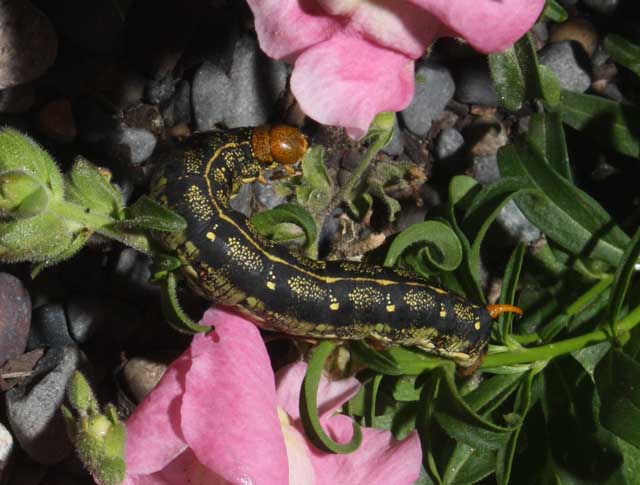Benton County, Washington
Sphingidae Larvae
Hyles lineata fifth instar on snap dragon, Benton County, Washington,
September 13, 2010, courtesy of Colin Miller.
|
|
Updated as per James P. Tuttle's The Hawk Moths of North America, July 2008 Dedicated as per personal communication with Colin Miller, September 14, 2010 |

Hyles lineata fifth instar on snap dragon, Benton County, Washington,
September 13, 2010, courtesy of Colin Miller.
Colin writes, "I was able to determine its family, Sphingidae, but not much else from the various links you provided.
"Location: Washington state (southeast corner)"
,font color=green>I reply, "It is one of the Hyles species of Sphingidae, probably lineata. I will have a closer look tomorrow. Please let me know the Washington County.
"I wish permission to post some of the images, credited to you, to a webpage?? I need your last name to credit it properly Do you know the plant upon which it is feeding?"
"County is Benton.
"Of course, you have permission to use them. Please host on your own
site; do not link to mine. My last name is Miller."
"That's a snapdragon being fed upon.
"It appears as though that caterpillar is the larvae of a White-lined
Sphinx hummingbird moth, which we have seen regularly up until about a
month ago."
For care of "found larvae/caterpillars" visit Manduca sexta larva, Travis County, central Texas, August 21, 2008, Trina Woodall.
Only seventeen Sphingidae species are listed for Washington on the U.S.G.S. website. Not all of the species are reported or anticipated in Benton County (Four are reported on U.S.G.S. as of August 25, 2008). It is hoped that this checklist, with the thumbnails and notes, will help you quickly identify the larvae you are likely to encounter. A "WO" after the species name indicates that I have no confirmed reports of this species in your county, but I (William Oehlke) expect that this moth with its larvae are present or might be present. I have included many species not on the USGS list for Washington; I believe they are or might be present
A "USGS" indicates the moth is reported in Lepidoptera of North America, #1. Distribution of Silkmoths (Saturniidae) and Hawkmoths (Sphingidae) of Eastern North America, an excellent little booklet available through Paul Opler.
Please help me develop this list with improved, documented accuracy by sending sightings (species, date, location), preferably with an electronic image, via email to Bill Oehlke.
Sphinginae subfamily
Smerinthini Tribe:
Macroglossinae subfamilyDilophonotini tribe:
Macroglossini tribe:
Hyles lineata fifth instar, Benton County, Washington,
|
This page is brought to you by Bill Oehlke and the WLSS. Pages are on space rented from Bizland. If you would like to become a "Patron of the Sphingidae Site", contact Bill.
Please send sightings/images to Bill. I will do my best to respond to requests for identification help.
 Show appreciation for this site by clicking on flashing butterfly to the left. The link will take you to a page with links to many insect sites. |